In cases, if you have in the country or in country house There is a fireplace or oven, then you know exactly what the chimney is. But at the same time, many do not know that during the operation of the chimney, one of the most common problems is in the thrust of the chimney. Let's talk now about how you can check the craving.
Checking thrust in chimney
You'll need : anemometer, sheet of paper, mirror, metal ball.
- It is best to check the craving in the chimney a anemometer intended for these purposes. Thanks to this device, you can get the most accurate data, but provided that the air movement will be 1m / s. To date, there are more advanced devices that allow measuring cravings in chimney with Pascals, even taking into account the fact that in different parts of the chimney and pressure can be different.
- To check the thrust, you can also leave the toilet paper to lower to chimney. In this case, the thrust force is established as its deviations, that is, the more deviation, the stronger the thrust. But its adequacy is determined visually. If smoke is observed into the room, then this tells us about the reverse thrust. And the flame is bright white with strong noise we can talk about his strength. But even if dark strips of red color appeared on the fire, then the thrust are not enough. When the flame in the boiler is a golden - yellow spike, then the thrust in the chimney is more than enough. The direction of thrust can also be determined on the smoke from the cigarette.
- You can check with a small mirror that you need to install in the smoke hood at the site of the thrust sensor. The mirror side turn towards the emission channel of flue gases. In cases of problems with smoke removal, gases will fall on the mirror, and therefore she is notice.
- For the following way, we need a metal ball with a diameter of 100 mm. To check the chimney to clog, it is necessary to omit it for the entire length of the channel. In cases where, before Niza, he does not meet any obstacles to the rest, it means there are no blockages.
From the article you will learn about the possibility of reverse thrust in the chimney, about tipping the thrust. How to identify problems in the work of the heating system and what to do if there is no thrust in the chimney?
What are the methods of increasing thrust in chimney and what mechanical devices will help to increase the thrust in the chimney? What is the effect of the damper on the smoke?
Perhaps you already have a fireplace or gas boiler, and maybe you are going to build a bath or sauna? Then you need a chimney to withdraw from the premises of the well-developed combustion products.
There is such a thing as a thrust in chimney. It occurs due to different temperatures in the pipe and outside, as well as due to different pressure indoors and outdoors. We'll figure it out what the reasons are the fact that the thrust in the chimney is bad, and how to improve the chimney craving
First of all, we'll figure it out why the thrust arises. Warm air has a smaller specific mass or density than cold, therefore the pressure will be less ( P \u003d Γghwhere γ - density, g. - acceleration of gravity, h. - Height). Due to the pressure drop, warm air will strive to upstairs, and it would be cold to push it.
Accordingly, the colder on the street, the better the thrust will be. The slowest traction will be in the warm season. But the inverse thrust in the chimney in the winter also takes place. The thrust characterizes the speed of the movement of the fuel combustion.
The calculation of the thrust of the chimney is carried out according to the following formula:
hC \u003d HD * (ρV- G) (mm water st)where
hC. - thrust of the chimney;
HD- effective part of the chimney, the vertical section of the pipe is taken at a distance from the pipe to the heating device;
ρv - air density;
ρG. - Density of substance from fuel combustion
For a more understandable, the values \u200b\u200bof the thrust can be translated into other units of measurement:
1 mm water st \u003d 0.0001kgs / cm2
What is craving
In the former times, there was an anemometer device that measured the traction force under the condition that the flow rate of "waste" substances was at least 1 m / s. Nowadays, there is also such a device, but already, so to speak, a new generation. It measures the craving in PA (units of measurement) and is not so cheap.
Is it worth gaining such a device or still use the "grandfather" method, to solve only you. How can you check the craving in the chimney with your own hands without having special equipment?
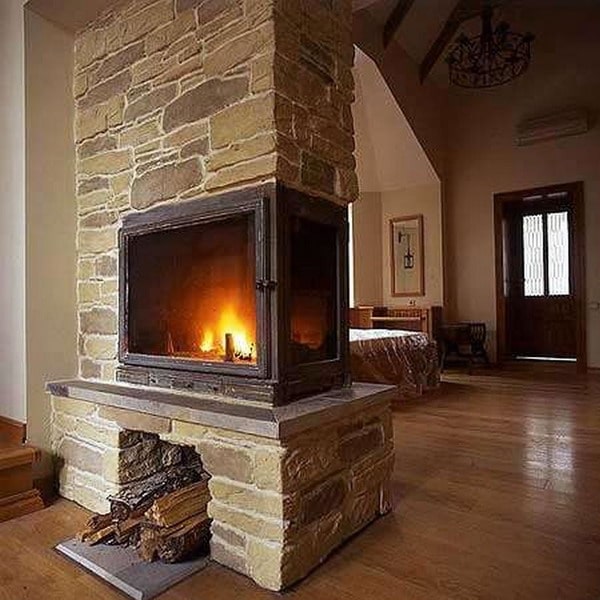
- The presence of thrust in the chimney can be determined by submitting a thin piece of paper (ordinary toilet paper is suitable for this case). If he rejected, then the thrust is.
- To safely, it is better to lower the extinguished mat, and in the direction of the haze from it you will learn, in which direction the thrust of your chimney is directed.
Visual ways to determine the thrust in the chimney
You can check the presence of thrust, just carefully by observing the heating unit:
- Sconcement of the room Speaks about the presence of reverse thrust.
- Flame has a pronounced white shade Or is there noise from the chimney. This indicates too strong pull.
- If a in the flame there is a dark red colorthat means this traction is not enough.
- The fire of golden, places of yellow color - a wonderful sign. Thrust in chimney what you need.
Why the chimney works incorrectly
If it turns out that there is no thrust or it is bad, then you need to try to figure out why it happened.
1. The most difficult situation is a poorly designed chimney (an incorrectly selected section, the diameter of the pipe or the height of the chimney is incorrectly calculated). If an inexperienced person is taken to do chimney with her own hands, he often admits fatal errors. If the reason is in an incorrect project, the only thing that can be done is to completely rebuild the smoke system.
2. Another answer to the question why there are no traction - it is a negligently mounted chimney (leakage of joints). In this case, you can eliminate the fault with your own hands.
3. Perhaps the chimney clogged, and it just needs to be cleared. To do this, you can invite a specialist or make work on cleaning with your own hands. Maybe in the room "walks draft", and due to these air flows, the work of the chimney is broken.
Reverse traction
Why does the reverse thrust arise and what to do when it appears? Reverse thrust is the wrong operation of the system of the heating device and chimney as a whole. The definition of "reverse traction" speaks for itself: "spent" fuel in the form of smoke is back to the room, instead of going to the atmosphere.
The reasons for the reverse thrust in the chimney can be the most different, ranging from the design and ending with the materials from which the chimney is mounted. Highlights that need to be checked with misuse of chimney.
- Error when calculating Overall dimensions of the chimney:
- the flue section of the chimney is chosen incorrectly;
- error in cross-sectional calculations leads to an incorrectly selected chimney pipe diameter;
- the height of the pipe is calculated incorrectly (the recommendations of the construction standards and the rules relating to the height and location of the chimney are not followed.
- Retreat from claims To the chimney device:
- there should be no lesions and narrowings of the section;
- the absolute smooth outer surface of the chimney;
- turning the pipes are allowed not more than a meter, if necessary, at an angle of 30 °;
- the chimney is not protected by a special tip from atmospheric phenomena (does not concern chimneys intended for gas boilers).
- Wrong mounting chimney elements:
- Exactness of the design.
- Inappropriate construction material For chimneys.
- Clogging of some sections of the pipe.
- Very cold air in the pipe Before starting the heating device.
- Nearby on the street, Gusty wind, atmospheric precipitation.
- The outdoor temperature above the room temperature.
Try to adapt all the reasons given above to your situation, and you will definitely understand why there are no necessary thrust in the chimney.
Tipping thrust in chimney
Tipping the thrust is short-term. For a short period of time, the "spent" fuel is retracting back to the room, then the thrust is restored. Provided that initially there was no such thing in the work of the chimney, it is possible to assume the causes of the occurrence of reverse thrust in the chimney.
- Normal chimney pipe clogging.
- The design has occurred.
- Behind the window there was a bad weather, possibly the fallout in the mouth of the chimney.
- Reduced atmospheric pressure on the street.
Methods for regulating thrust in chimney
If the check showed that the thrust force is insufficient, measures should be taken. Various cravings will help the knitting knob. Moreover, the device will do it automatically, maintaining the optimal pressure from 10 Pa to 35 Pa in the pipe. If necessary, the instrument can both increase the thrust in chimney and reduce it. So, this device will always keep the craving under control, which will ensure the optimal work of the entire heating system.

Increased thrust in chimney can be achieved by increasing the chimney pipe. The height of the pipe can be greater than is written in the regulatory documentation, but everything should be within reasonable limits.
Please note that the pipe is not worth doing too long, it will only make it difficult to extend the "spent" fuel, and it will be much more difficult to clean such a pipe.
How to strengthen the thrust in the chimney without resorting to the change of the design:
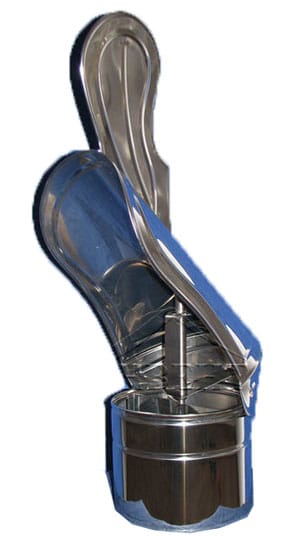
Now you know how to increase the thrust of the chimney using mechanical devices.
Be careful, the installation of mechanical devices should be considered individually for each heating unit.
The role of the damper in the work of the heating system
The damper, or the Sewber for the chimney, protects the house from ignition and prevents the possibility of reverse thrust.
It is mounted:
- in the furnace door (fireplace) or is located in the oven itself (fireplace);
- directly into the chimney pipe.
The chimney valve acts as a chimney thrust regulator. Closing the damper, reduce the cross-sectional area of \u200b\u200bthe chimney, respectively, the thrust decreases. Open the damper, the cross section increases, and the thrust of the chimney too.
After the fuel burned in the heating device, you can close the Sewber, thereby reducing thermal losses. The oven or fireplace will cool not so quickly, which will save on the fuel.
What is a traction stabilizer
The chimney thrust stabilizer, or the interrupter, the secondary air supply device with doses, allowing you to maintain optimal traction. The breaker has a protective valve that prevents overpressure.
Taking advantage of the following tips, you can avoid problems with the chimney:
- If cold air is present in the chimney, then before the ignition is worth burn a couple of reversal newspapers. Cold air is heated, it will become warm enough, and when Ignoring the heating device, a reverse thrust will not occur.
- Chimney requires pipe cleaning At least twice for the heating period (see how to clear the chimney). If you neglect the rules of the smoke operation, it can be elementary to clog. It is because of this that the thrust in chimney may decrease, and also the possibility of reverse thrust in the chimney appears.
Now you can easily understand the work of your heating system.
The work of heating devices, as well as the safety of residents of houses with the thrust in chimney, depends on chimney heating. The elimination of possible problems will help you feel in your home comfortably and confident. You can increase or adjust the pressure indicator with your own hands.
Useful information about pulling in chimney
All residents of country or private urban homes are familiar with such a thing as a thrust in chimney. Do they know the essence of this term?
If a little bit away from the dry scientific terminology, the craving can be defined as a natural phenomenon in which the air moves from one area to another - namely, from the air zone increased pressure In the zone S. reduced pressure. All this happens with the help of a ventilation device - a special channel in chimney.
Using such a process of aerodynamics, humanity began to use fireplaces, furnaces, boilers, heating their dwelling with different species Fuel - coal, firewood, peat, etc.
With a good traction, the furnace quickly flares up and the room is filled with a pleasant warm
From a properly designed and constructed chimney and, accordingly, from good traction depends:
- quality heating room;
- reduction of fuel costs;
- safety of finding in buildings with its own heating.
What affects the amount
There are three groups of factors that must be taken into account when building and checking the chimney.
Outdoor moments
A number of factors, indoors, can significantly affect the presence / absence of traction and its strength:
- The material from which the building is erected.
- The average indoor temperature.
- The maximum volume of airspace in the dwelling.
- The number of people constantly located inside the housing.
- The presence of internal sources, additionally consuming oxygen (calorificates, heaters, stoves, etc.).
- Regularity of fresh air intake (ventilation, ventilation).
External factors
There are other factors that determine the thrust of the chimney, and they are out of heated premises. We are talking about the temperature of the external environment, atmospheric pressure, humidity, wind direction. Such a phenomenon, as temperature change during the day, can also influence the thrust due to the movement of cold and warm air layers.
Difficulties with the burden appear from different reasons, some can simply not notice. For example, problems with the yield of air through the chimney may occur if the pipe is much lower than the skate of the building or high chicken trees.
Features of the design of chimney
The thrust can be different depending on the design characteristics of the chimney:
- height;
- the presence of insulation;
- tightness;
- location (internal / external);
- length;
- presence / absence of irregularities or roughness, etc.
It is necessary to control the accommodation in the room and possibly using the "levers" of the first and third factors (domestic and design). Natural changes naturally do not depend on person.
Keep under control in chimney - a prerequisite for safe and comfortable stay in your own premises. If the thrust is very weak, it is almost impossible to ignite the oven and heat the dwelling.
With inverse damage, there is a "throwing" gases resulting from burning, in a residential premises, rather than air through the pipe. It is very dangerous for the health and life of a person!

It is impossible not to notice such an atypical behavior of smoke
With a very strong pull, everything heat is rapidly pulled through the channels of the chimney outward, not having time to warm the heated room to the desired temperature.
Why reverse thrust appears
Weak thrust can be the base for the formation of the reverse thrust. How can I recognize that with a burden not all well?
This "say" moments that can be consistent with the unarmed look: a lot of smoke in the oven, smoking on the door, an intramonomous flow of smoke. In other words, smoke, nothing from the combustible fuel does not go into the chimney pipe, but seeks to get into the residential premises with an open door and through the slot.
Causes of reverse thrust:
- Design flaws of chimney. Low pipe is an increased risk of reverse thrust. The higher the pipe, the better the process of pulling the exhaust gases and smoke. The optimal height of the pipe is about five meters.
- The correspondence of the pipe diameter parameters of the furnace device. For a powerful furnace, a chimney with a container of a rather big cross section is required. But here the measure is very important, since the use of too wide pipes will make the process of firebox unprofitable (all warm air literally will fly into the pipe). Invalid use in chimney of several pipes with different cross section!
- Use non-low pipes. Rights, chips, roughness, etc. - - obstacle for good thrust. Over time, the chimney hole can be dried due to the suits of soot and other elements of combustion and impede the process of extroduction oven, its normal functioning.
- Violation / lack of ventilation. Drafts, open windows in the premises above the furnace, do not help the process of combustion of fuel, and distort it, making it useless and unsafe.
The channels of the chimney, made of metal, are largely inferior to brick tubes. Fast heating and the same rapid cooling do not benefit the heating system as a whole and chimney, in particular.
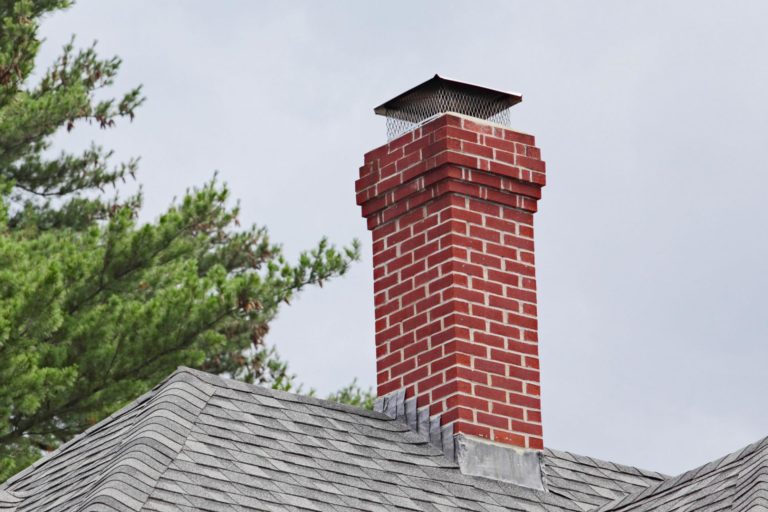
Brick pipes are much more efficient in smoke exhaust plan
Reverse thrust may appear on objective, independent of humans, reasons. Strong gusts of wind, rainy, cloudy weather with high humidity - unfavorable moments in terms of education problems with a burden.
There is such a term as temporary reverse thrust. What is it? In this case, it is worth talking about the violations of the temporary thrust, for several days. After a certain period of thrust again goes back to normal.
Temporary reverse thrust can happen due to cold premises, for a long time of unheated. Very cold air accumulated in the chimney pipe prevents the rapid fuel fuel. Therefore, smoke can "pushed out" from the chimney into a dwelling, bath or other room with a stove or fireplace.
Eliminate the cold air in the chimney is very easy - warm the pipes by burning in the ovens of ordinary newspapers, wallpaper, paper. The main thing is that these materials be well sucked.
If problems with the burden can be fixed constantly or with a certain periodicity, then it is necessary to take steps to eliminate bad thrust.
Check for power
Before throwing strength to fight a bad burden, make sure that the thrust really leaves much to be desired.
You can check the craving using special devices or yourself. Simple ways Checking:
- Light a paper sheet, let him chase a little. Running to the oven or fireplace, put off the paper and watch the direction of smoke. If it goes to the pipe - a good thrust, deviates in the opposite direction - the reverse thrust if it retains "straightness" - there is no traction. Such manipulations can be done with fine tissue or toilet paper, without filling it on.
- If there are smokers in the house, then follow the direction from smoke cigarettes or from a flame match, lighters near the fireplace or oven. Conclusions do similarly to the first item.
- The flame of the ordinary candle can also help in the definition of thrust in the dwelling.
- The pocket mirror brought to the furnace and the condensate covered can talk about problems with the removal of smoke from the furnace.
- About the presence of too much thrust that takes pleasant heat out of the room, testifies the hearing hum in the oven - a loud buzz.
- The color of fire in the firebox can be an indicator of different traction. Golden shade - good traction, white flame - excessive traction, red roller and black smoke - bad thrust, High probability of reverse thrust.
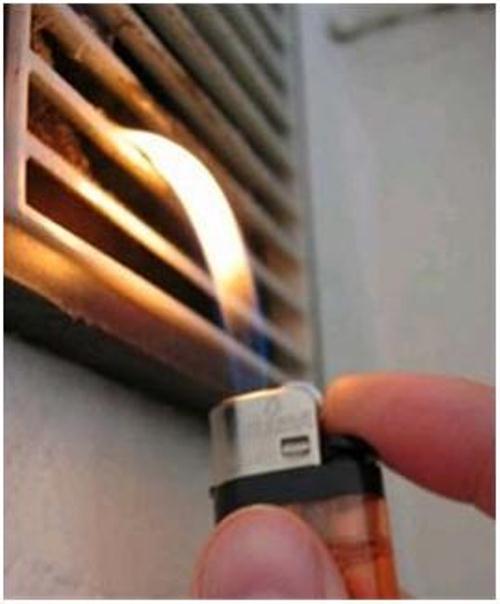
An ordinary lighter can help in checking traction
Anneometer - a device familiar to many people of the Soviet period. With this device, it was possible to measure the thrust of the chimney. Normal readings were considered within 10-20 Pa. Disadvantages of the device in its low accuracy at the strength of the wind less than one meter per second.

Such an easy device will help secure your life in a house with furnace heating.
The modern industry offers a sufficient number of devices for measuring the thrust, there are instruments that lock the craving at the inlet and the outlet of the chimney.
Methods for troubleshooting
If you stated problems with a burden, then, of course, they need to be eliminated as quickly as possible.
The choice of funds to combat bad or reverse damage depends on the reasons leading to the abnormal operation of the chimney.
Pipe cleaning
One of the common ways to improve the thrust is cleaning the pipe. Fuel, burning in the oven, highlights various substances that settle on the inner surface of the chimney. The soot adheres well to the pipes if they are uneven or curved.
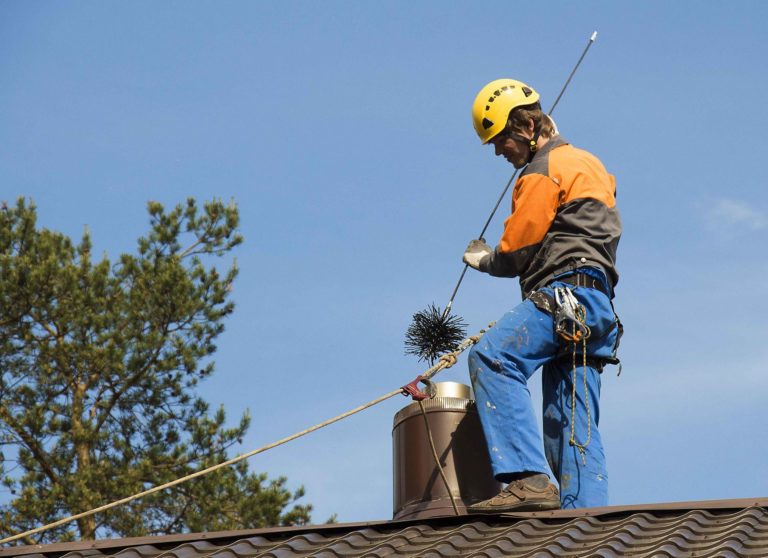
During work, do not forget about safety measures
How to clean the chimney to appear good traction?
First of all, acting purely mechanically. The chimney channels can be made wider, getting rid of the climb, in the following ways:
- Cooking around one potato bucket, clean it and cut it. Potato cleaning is also suitable. Splinse the little to the furnace and wait. When combustion, potatoes will allocate starch, which will become a means capable of softening curbing education. Soft pieces of soot will disappear themselves, and finished sticking will have to be removed by mechanical way.
- Firewood from aspen. Protect the oven with two three minutes. They greatly dispel the chimney pipes and help get rid of Nagara. But this method requires special caution, since the likelihood of fire will be very high (soot can light up).
- Rock salt. This method is more suitable for prophylaxis. Salt added at the time of the furnace improves the condition of chimney pipes.
- Pipe scrach. The heavy load is attached to the rod suspended onto steel rope, and lowered in chimney holes. Updated and lifting this design, you can force the seasy formation to fly from the walls of the pipes and fall into the oven. From the furnace, these fragments are then extracted.
The second group of antique events is built on the use of chemicals. The most popular chemicals for the cleaning of the chimney are "Polyse-Petrychik", "comungiles". To coals formed in the process of furnace furnace or fireplace, added according to the instructions of chemicals and continue to stir. After burning all the fuel, it is desirable to leave coals, since they continue to "work" in terms of cleaning the chimney (at least they advise the manufacturers).
Do not believe the worships that talk about compulsory sage fires when using a chemical method. This method does not represent any danger, since the useful action goes at the expense chemical reactionsand not due to ultrahigh temperatures of burning reagent.
It should be particularly important about compliance with security measures when carrying out all works concerning the chimney. Do not eliminate chimney problems in windy weather! Try to use the safety devices during the work at the height!
Elimination of structural troubles
When identifying certain features of the chimney design, which negatively affect the force of thrust, adjustments should be made to eliminate them. To such actions should be attributed:
- dismantling several scattered pipes and installing a single chimney channel;
- pipe add-on to the roof to the height;
- insulation of chimney elements, etc.
Ventilation arrangement
In some cases, the thrust can improve, if not allowed drafts in the house or bath. Help with problems with the burden you can install ventilation devices on the window.
In the absence of due effect after all the above methods, modern devices should be adjusted to improve thrust in chimneys.
Installation of instruments
To improve the work of the chimney, it is best to use special devices that allow you to adjust and control the traction. Such devices can be bought in the store or make it yourself.
Special devices for regulation
Modern instrument maiders took care of the release of special devices controlling the chimney:
- Regulators. They are installed on the outlet nozzle of the chimney to normalize the thrust in the heating system, as well as as a means affecting the efficiency of heating.
- Deflectors. Such instruments are fixed on chimney from the outside. The improvement in the speed of the traction is carried out due to the fact that the diameter of this device is much larger than the chimney pipe, and, it means that there is a low pressure region when it flows around with air flows.
- Chimney vane. It is a special design that performs several functions at once: improves cravings, protects the pipe from raindrops and snow vortices. The device's action is similar to the work of the deflector, the thrust speed is normalized by reducing the external resistance of the air.
- Smoke fan. It is very popular among house owners with a heating system. Artificial air vortex is created inside the chimney thanks to the operation of the ventilation system, to connect which electricity needs. Compliance with all necessary security measures is a prerequisite for the installation and operation of such a device for improving chimney traction.
All devices installed on the chimney pipe to improve thrust require mandatory control, especially in winter. This is due to the fact that additional devices attached to the chimney from the outside can be scored, iced (in winter) and thereby preventing the normal operation of the chimney. The blockage obtained by the "with the participation of" devices may cause the occurrence of reverse thrust and penetration of carbon monoxide into residential premises.
Do not forget to regularly examine together with chimneys and instruments that help increase craving.
Photo Gallery: Drive Control Devices
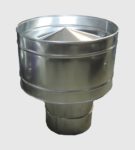 The most common device among donated heating users
The most common device among donated heating users 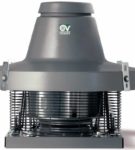 Such a device is especially relevant to improve the work of furnaces and fireplaces
Such a device is especially relevant to improve the work of furnaces and fireplaces 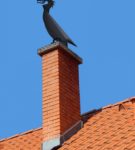 Useful and beautiful device
Useful and beautiful device 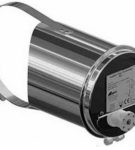 By installing such a device, you can improve the work of the entire heating system.
By installing such a device, you can improve the work of the entire heating system.
Self solving problems
Let's try to make the process of firebox safe and efficient. The most common way to combat sauce accumulations in the pipes is a lubshik with a ship.
Clean the pipe of the jarshik
To begin with, we will prepare everything you need:
- Hard lingerie from the bristles. The diameter of this adaptation is selected taking into account the cross section of the pipe (from fifty to three hundred millimeters).
- Thin metal cable (can be replaced with a very durable rope or rope).
- Cargo for hanging to the rod.
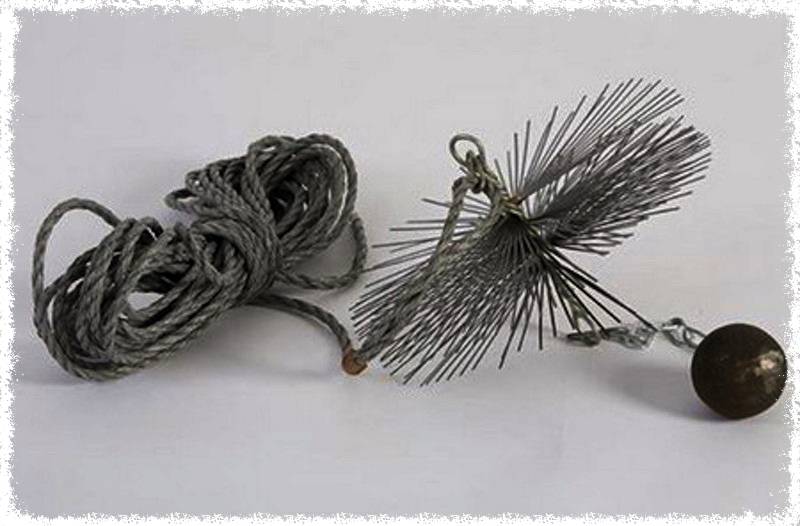
This is how the device is looking for a chimney pipe
Do not go to work if the street is a strong wind or too much humidity. Try to think over and use reliable insurance to protect yourself from unforeseen cases.
The YORS is dried by driving, attaching it to the bottom of the device. The lubshik himself is brought to the cable. All fasteners should be especially reliable, otherwise the design will decay and you will have to produce additional actions - on the "learn" of them from the pipe.
First, they clean all the holes of the chimney revision, and then proceed to clean the pipe itself. Making several movements up and down, you can get rid of soot, which from the pipe will fall into the oven. Best of all, if someone else will be near the oven to signal the efficiency and the time of termination of work.
You should finish cleaning the pipe when soot stops drying.
It is possible to clean the pipe with the help of well-made means, what a lot of videos are removed.
Video: Clean the pipe with undergraduate means
Selection of devices for regulation
Consider some of the characteristic features and methods for using instruments to control and adjust the thrust.
Such structures are installed on smoky pipe (in her top) To create obstacles to air flows. The wind power intensity falls noticeably when meeting with such devices supplied to the pipe. Smoke comes through the channel "on the will" due to the ingress of weak air flows. These streams "engage" the exhaust gases and "push" their outwards.
Deflectors exclude the likelihood of clogging pipes, as well as made with taste, significantly improve appearance all buildings.
There are several types of deflectors:
- TsAGI;
- round Volpert;
- Grigorovich;
- in the form of a plate;
- in the form of the letter H;
- rotating;
- vane.
Almost all of these devices are made of stainless steel, in rare situations - from copper. Using brackets, clamps, bolts, sealing tape, the deflector is attached to the chimney pipe. Some devices are also equipped with additional functions: to clean the sparks (to eliminate possible roofing), to control the temperature of the outgoing air (in this case, the sensor is triggered if hot air does not leave and there is a probability of reverse thrust).
Disadvantages of use of deflectors - in their minimal efficiency in light weather.
Photo Gallery: Types of Deflectors
 The most common device for improving traction
The most common device for improving traction 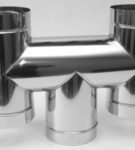 Such a device can be purchased in specialized stores.
Such a device can be purchased in specialized stores.  The choice of device depends on the structural features of the pipes and your preferences
The choice of device depends on the structural features of the pipes and your preferences
Turbines installed in the chimney glider use wind energy capabilities. The air flows lead to the rotational nozzle (it is always moving in one direction), and thereby air is vacuuming near the chimney. It is eliminated completely inwarding the chimney with a rotary tube of any foreign objects and precipitation.
Rotary pipes have a big minus, similar to the work of the deflector. Their use in a windless day is ineffective.

If you do not have big abilities, buy such devices - not a problem
Regulators of traction
Such devices are a real find for residents of country houses, bath lovers and firewalls. These devices are attached to the chimney of the boiler. They are equipped with a metal plate with a load that bales it on one side. When the thrust is good, the metal plate does not prevent the free access to the chimney. With a weak or reverse line, the metal plate serves as a peculiar stupor.
Range boundaries for thrust sets the consumer itself, the usual parameters - 10-35 Pa.
The device works absolutely autonomously, it does not require an electric current.
How can I zoom in your own hands: homemade devices
Before proceeding with the construction of the deflector on their own, weigh your strength, look at the available materials and only then proceed to business.
Drawings and schemes
To create a deflector, you need to use diagrams and drawings. You can use ready-made, in large numbers presented on the Internet, and can be done by relying on these finished schemes and drawings.
Photo Gallery: Ready Diagrams for Traction
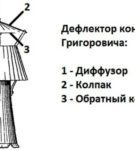 On the Internet you can find a good help for facilities
On the Internet you can find a good help for facilities  Carefully examine the diagrams of the appliances and select the right one for you.
Carefully examine the diagrams of the appliances and select the right one for you. 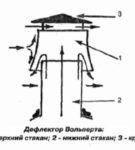 The diagram shows the device for this device for improving traction.
The diagram shows the device for this device for improving traction.  The circuit shows the components of this device
The circuit shows the components of this device
If you decide to check ourselves and at the same time to save, arm yourself with measuring instruments to determine the inner diameter of the chimney. Depending on this value, you can, focusing on the table, determine the necessary parameters of the height of the deflector and the width of the diffuser.
With internal diameter 120 mm, these parameters, respectively, 144/240, for diameter 140 mm - 168/280; If the internally section is 200, then 240/400; For a cross section of 400 mm, the height of the deflector -480 mm will need, and the diffuser width is 800 mm.
It is possible to calculate the necessary parameters (for a specific diameter of the pipe) and by using uncomplicated calculations. To determine the width of the diffuser, the inner diameter of the pipe must be multiplied by 1.2; The width of the umbrella for protection is considered -1.7 x D; We learn the overall height of the design if you multiply the internal section by 1.7.
After receiving all the sizes, we build drawings for more accurate cutout. We draw diagrams on a sheet of watman or on the back of the remaining pieces of wallpaper.
It is best to build a pretentual in full size. In order to simply attach the cut-off paper parts to the steel sheet and do not engage in data recalculation, taking into account the scale of the drawing.
Forest materials and tools
Everything needs to be prepared in advance so that during the work is not distracted.
We will need for the manufacture of a deflector:
- galvanized sheet thickness of at least half a million, can be used and stainless steel;
- scissors for metal;
- drill with different rods;
- device for rinse
- a hammer;
- pliers;
- clamps, nuts, bolts;
- marker (to translate the drawing to the metal sheet).
Preliminary stage
Preparatory work lies not only in the drawing of the details of the device, but also in cutting them and fitting. All paper elements are fastened with a closure or stapler and apply to each other. If everything is suitable, you can carefully remove the ass on and reap template.
It is not necessary to negotiate the process of creating a deflector, try to think about your safety. In order not to damage the hands and to protect the eyes, use the prepared in advance gloves and special glasses.
Getting to work
So, everything is in place, you can start!
Step-by-step description of the sequence of actions will help you:
- We translate parts cut from paper to galvanized sheet. We should have an explorer of the following elements: a cap, diffuser, an external cylinder and racks.
- Using the metal scissors, carefully cut out all the components of the deflector components. In places of sections, the metal is fucked by pliers on the semillimeter thickness and "pass" with a hammer.
- Diffuser blanks, cap and cylinder fold and drill holes for fasteners (if bolts are used). Connections are performed using ripples or bolts, in exceptional cases, you can apply welding (semiautomatic).
- For fastening the cap prepare 3-4 strips of metal. The size of the strips is 6 per 20 cm. Strips, bent off the edges and covered with hammer, it is necessary to exacerbate in the form of the letter P. on the cap, five centimeters from the edge to drill 3-4 holes and with bolts to fix metal strips.
- Other ends of strips from galvania must be attached to the diffuser, thereby "looping" the cap and diffuser.
- The resulting design insert into the shell.
About the construction of a deflector of the TsAGI with their own hands can be viewed in the video.
Video: TsAGA deflector do it yourself
Installation of deflector
The first way is to climb onto the roof and, observing safety, attach the device made to the chimney pipe.
You can make your work a little easier - attach the deflector to an additional pipe, which is then lifted to the roof and insert into the main pipe.
The homemade device put in place the second, more secure and convenient way. We will need a piece of pipe with a slightly large diameter than the chimney pipe. Returning from the edge of the cut pipe of centimeters fifteen, mark and make holes, we produce the same manipulations on a wide part of the diffuser.
Big buildings also need to install devices for adjusting thrust
Process independent adjustment The traction is necessary in order to comfortably and safely live and relax in the house with furnace heating. To do this, you can use different wayswhich are suitable for your chimney design: cleaning the pipes of the jarshik, "chemical cleansing firebox", installation of special devices. Drive control devices can be bought or done independently.
The combustion products formed during the operation of the heating boiler, with the air flow, are carried out by chimney to the street. The process of flowing the flow on the exhaust channel is called a burden. It arises due to the difference in pressure and the density of cold air and heated in the furnace or the boiler. The incorrect design of the chimney or its clogging lead to a decrease in the intensity of the air flow, and sometimes change its direction to the opposite. Weak thrust reduces the efficiency of the heating system, and the feedback is a danger to health. To improve the burning of fuel in the boiler, you need to know how to increase the chimney craving.
Verification of traction with remedies
The productive operation of heating depends not only on the presence of thrust, the quality of fuel also affects the combustion temperature. To exclude other factors, you need to check whether the air is moving along the chimney. How to check craving without a special device? This will require objects available at hand, and simple actions:
- The burning match is brought to the flopping compartment, with a normal pull, the flame is drawn into the oven.
- The burning candle is placed near the chimney and extinguish, the direction of air movement is determined by the smoke.
- Listed thin paper is inserted with a channel hole and follow the oscillations.
- The thrust is not only insufficient, but also excessive, while the heat is quickly carried into the atmosphere. A strong air flow makes the flame in the firebox to buzz.
Lack of traction
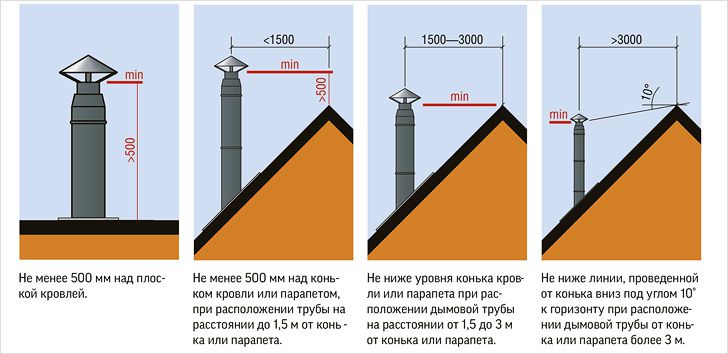
It is important to determine why there is no traction. Reducing the thrust provoke various reasons:
- incorrect design of the chimney channel;
- low location of the edge of the pipe relative to the rod of the roof;
- deposition of a large amount of soot on the walls of chimney or other types of clogging;
- climatic conditions - low pressure, high humidity, strong wind;
- insufficient air flow due to poor ventilation of the room;
- violation of the tightness of the channel.
Finding out the reason for the reduction of thrust, immediately proceed to correct the situation. Most of the listed defects can be eliminated independently.
What to do

And now we'll figure it out how to improve cravings. Design errors, such as the narrow pipe diameter or numerous channel bends, will have to be eliminated, but other cases have more simple solutions. The insufficient height of the pipe is corrected by increasing if brick was used, then additional masonry is carried out. An additional part is fixed on the metal tube, the adjusting structure to the recommended height is 5 m from the furnace.
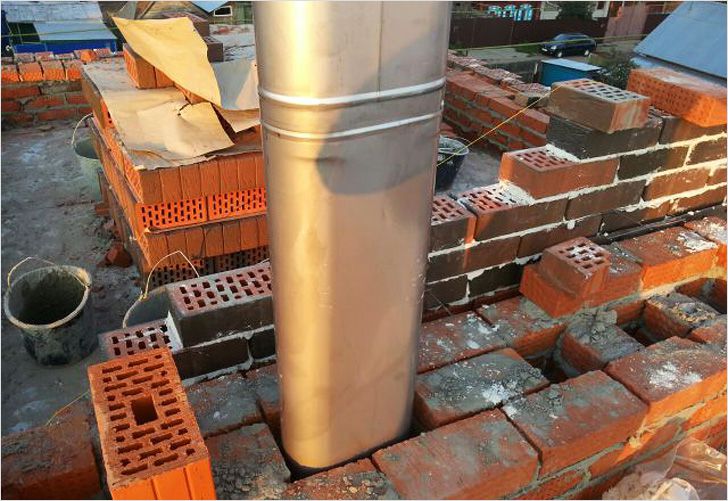
The narrowing of the channel caused by the accumulation of sootium reduces the volume of the transmitted gas. To clean the chimney make a simple device from the rash and cargo tied to the rope. The device is lowered into the pipe and progressive movements clean the passage.
The disruption of the tightness of the brick chimney is eliminated by the lubing of the slots with the solution, if necessary, shift a portion of the pipe. With a sufficient and direct structure of the channel, a ceramic or metal pipe. Chimney becomes hermetic, and round cross section The channel is more efficient for gases, than rectangular.
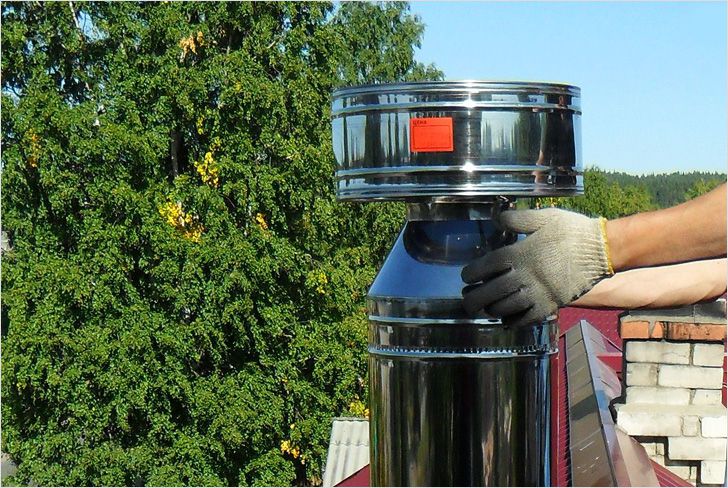
Note! The rarefied air in the room does not give enough oxygen and has low pressure, it provokes a reverse traction. To increase the pressure, you need a good ventilation, just open the windows for several minutes and the composition of the air will be restored.
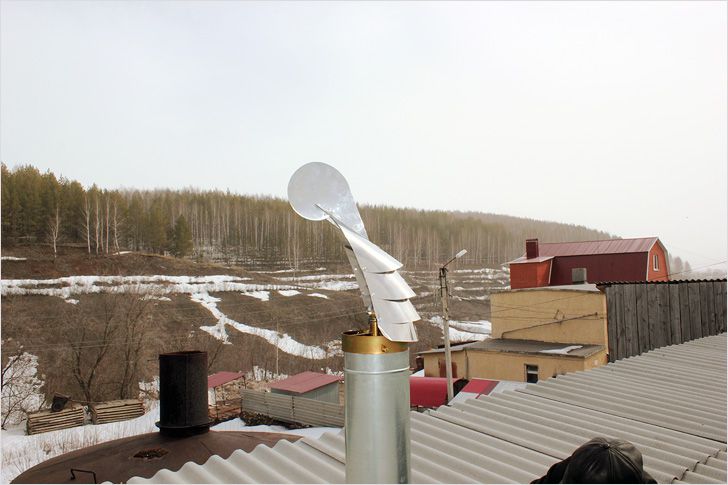
With unfavorable weather there are several ways to improve cravings.
- If on the street low temperature Cold air creates pressure preventing outgoing flow. To warm the pipe, you can burn some paper with it, it is also important to take care of the insulation of the structure.
- Use a strong wind to gain thrust allows the installation of a deflector. This device is placed on the pipe, at the time of the exposure to the air masses there is a low pressure that promotes the increase in thrust. The diameter of the deflector depends on the size of the chimney. In the absence of wind, the device does not have a reinforcing effect. Devices are made of stainless steel, they are resistant to high temperature and humidity.
- A similar effect has a rotary turbine installed on the ledge. It is spinning under the action of wind and creates air movement in the smoke canal. The design in the form of a bowl with blades protects the smoke channel from precipitation and foreign objects. The turbine is installed for a gas boiler with a low temperature of the outgoing gases.
- Protect the mouth of the pipe from the wind of the wind allows the installation of a fluger. The device turns so that the smoke leaves from the leeward side, and the flowing air enhanced the thrust. Reduces the likelihood of tipping thrust in chimney. In order for the moving part to not suffer from corrosion it must be lubricated, and periodically, the fluger is cleaned from soot.

Note! One of the reasons for the absence of thrust can be a closed Sewber (flap) of the chimney, if the reason for this, then after opening the air flow is normalized.
Device stabilizer traction
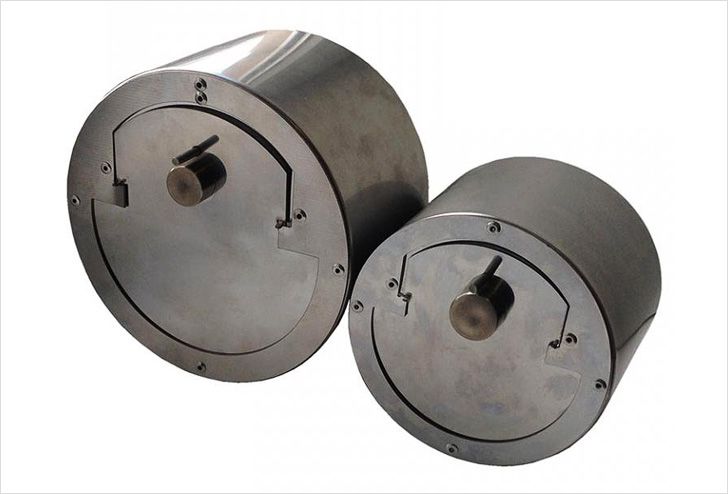
The traction stabilizer is a pipe having an expansion in the form of an umbrella. In this place is a hole for air intake. The operation of the stabilizing device controls the sensor. When accumulating gases from reverse thrust or poor passage through the channel, it heats up and turns off the boiler. After eliminating the causes of the deterioration of thrust, the heating device is again included. The stabilizer by supplying additional air optimizes the speed of movement of the gas in the chimney. It automatically changes the intensity of the movement of combustion products, depending on the situation increases or reduces the thrust.
Installation of forced traction
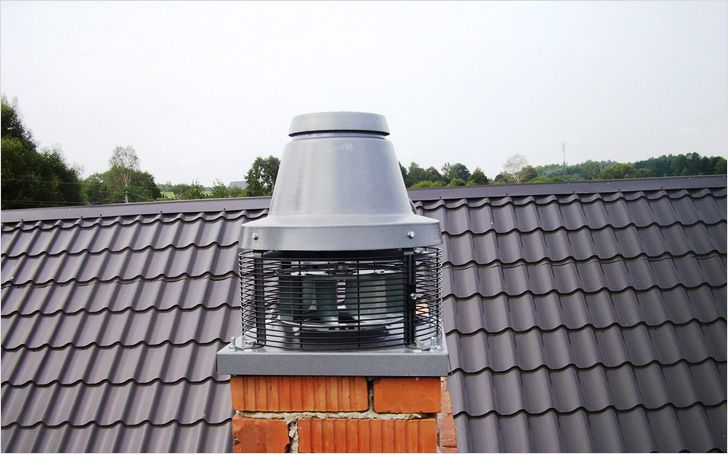
Even minimal thrust is normalized using a heat-resistant fan installed on the chimney channel. The device runs from the electric motor and requires the labeling of the wire to power from the network. This is the most effective solution that allows you to activate the movement of the air mass in the chimney, despite the weather conditions or other factors. Through the rotation of the blades of the smoke, forced thrust is created. The electrical device will improve the gases to improve even in the channels where a small pipe diameter is chosen. The insufficient height of the chimney is also compensated by the installation of the fan. Unlike mechanical devices, working only on wind energy, an electric fan is ready for operation under any conditions.
A good thrust is an important component of the effective functioning of the heating system, work on its control and amplification will ensure the stable operation of the boiler or the furnace.
Chimney is necessary to solve two tasks: removing hazardous combustion products outside the room and to ensure the inflow of oxygen to the place of burning of fuel. For gas boilers, the correct chimney work is no less important than for furnaces or fireplaces. Consider how to check the thrust in the chimney of the gas boiler.
Traction
An indicator characterizing the efficiency of the chimney - traction. The intensity of the thrust determines the speed of the air mass in the pipe. The higher the thrust, the faster the combustion products are removed and the better the inflow of oxygen to the flame.
The thrust is caused by the pressure difference between the upper and lower point of the chimney. All other things being equal, the higher the pipe, the better the thrust.
Risks
What threatens a weak thrust or her absence? The risks of this phenomenon are extremely serious:
- Arrival of combustion products (carbon monoxide) to a room with relevant health problems. Curly gas and the rest of the components of smoke are destructive for humans. Especially dangerous inconspicuous increase in the content of harmful gases, for example, at night. Depending on the concentration and time of exposure, a person can get rid of the headache, and may come and more sad consequences.
- Lack of oxygen to maintain combustion. In the case of a furnace, nothing particularly scary will happen - the furnace will go out. But in the case of a gas boiler, the fuel attenuation without turning off the supply of fuel will lead to the accumulation of fuel material indoors. In addition to the prospects for poisoning, the danger of an explosion is added.
If a clear smoke is visible or a gaspace is felt by smell - the boiler must be turned off, and the room is checked with a draft. If the color of the flame is changing towards red, this indicates the lack of oxygen, which, in turn, speaks about the emerging problems with the burden.
How to check this indicator?
To avoid specified risks, before using the boiler, it is necessary to check the presence of thrust. The test methods are as follows:
- Anemometer readings. This is a special device used to determine the speed of gas movement (often called the "winder"). Modern anemometers allows you to accurately determine the value of thrust and come to the reasonable conclusion about the feasibility of starting the equipment. Unfortunately, a high-quality measuring device will be not cheap.
- Visual "grandfathers" methods. A leaf of light paper (for example, toilet), brought to chimney, will show the presence of thrust and its intensity. The more leaf deflects under the stream of wind, the better the thrust. Similar information will give us smoke from a cigarette placed in chimney.
- Checking mechanical blockages. The common cause of problems with the removal of smoke is clogged in pipes. You can check the presence of a blockage using a metal bowl that descends on the rope from the top point of the chimney to the bottom. If the ball got to the end without problems, then the chimney is clean. The presence of problems with the discharge of smoke in this case means the availability of problems in another area (short or not enough wide channel).
Check the presence of a blockage is possible using a visual inspection, if it allows the design of the chimney.
Output
With any suspicions relating to the violation of thrust, it is necessary to stop the boiler until you figure it out with the situation. The best way Verification of the indicator is the use of an anemometer, but for estimated definition of the presence of traction, a sheet of paper is enough.




